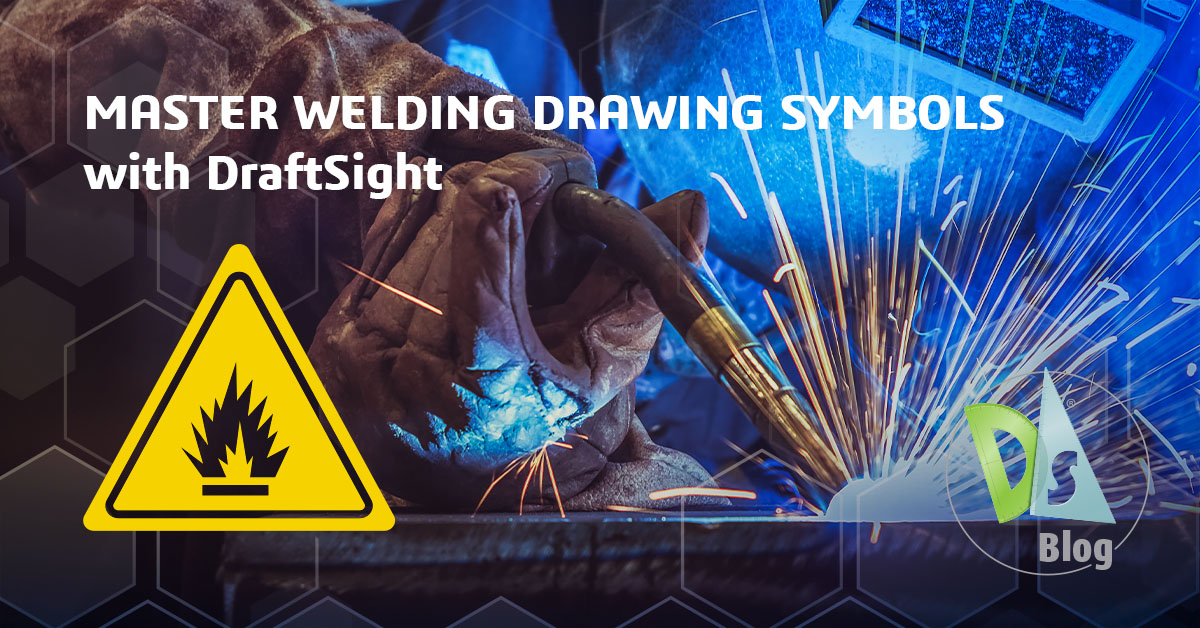Master Welding Drawing Symbols with DraftSight
Precise communication is essential for ensuring high-quality welding outcomes in design projects. Welding symbols, as part of your CAD toolkit, play a vital role in maintaining clarity and accuracy within your drawings. With DraftSight’s Mechanical Toolbox and its specialized features, understanding and applying welding symbols has never been more streamlined.
This guide provides an overview of welding drawing symbols, their practical applications, and step-by-step instructions for using them effectively in DraftSight. By the end of this blog, you’ll be equipped with actionable insights to enhance your drafting skills and easier ways to collaborate with fabricators and engineers.

Why Welding Symbols Matter
Welding symbols are a standardized way of conveying detailed welding instructions, including weld type, size, and joint configuration, without overcrowding your design. These symbols help ensure designs adhere to industry standards, fostering better communication and reducing the risk of errors during fabrication.
Imagine having a clear visual shorthand on your drawings that both designers and welders can easily interpret. That’s the power of these symbols, and with DraftSight, incorporating them is efficient and intuitive.
Common Welding Symbols in DraftSight
DraftSight’s Mechanical Toolbox simplifies the inclusion of widely used welding symbols. Here are a few key types of symbols and their applications:
Fillet Weld Symbols
Fillet weld symbols indicate triangular welds and are commonly used for lap joints, T-joints, and corner joints. Their simplicity and versatility make them one of the most popular welding types.
Groove Weld Symbols
Groove welds represent joints that require specific preparation, such as square, V, or U grooves. These symbols are typically found in butt joints, ensuring a strong, seamless weld.
Spot Weld Symbols
Spot welds are pivotal in sheet metal work, marking locations where overlapping materials are joined via weld points. Their efficiency in assembly-line manufacturing makes them indispensable.
A Helpful Tip
For a complete overview of all welding symbols and their meanings, refer to a welding symbol chart. This can be an invaluable resource when navigating the details of your project.
Step-by-Step Guide to Adding Weld Symbols in DraftSight
Adding welding symbols in DraftSight is simple and straightforward. Follow these steps to include precise weld indications in your drawings:
Step 1: Access the Welding Symbols Tool
Open the Mechanical Toolbox and select the Welding Symbols icon.
Step 2: Configure Symbol Properties
A dialog box will prompt you to configure the following properties:
- Display: Choose the side of the reference line (arrow side or opposite).
- Symbol Type: Select the appropriate welding symbol based on the design requirements.
- Finish and Contour: Specify the surface finish and contour type.
- Size and Number: Input the weld size and number of required welds.
- Length and Pitch: Define the weld length and spacing (pitch) between welds.
- Angle and Root (if applicable): Set groove angle and root opening for groove welds.
Step 3: Insert the Symbol
After finalizing the configurations, click OK. Use your cursor to place the symbol at the desired location within the drawing by specifying its start and end points.
Additional Resources
For detailed instructions, refer to the DraftSight Help documentation on Adding Welding Symbols, which provides further guidance to optimize your workflow.
Best Practices for Using Welding Symbols on Drawings
Ensuring clarity and accuracy in your weld drawings is critical for successful fabrication. Here are a few best practices to keep in mind:
Use Standardized Symbols
Always adhere to established industry standards for welding symbols. This prevents misinterpretations and ensures consistency across projects.
Double-Check Accuracy
Verify that each symbol matches the specified weld requirements, including size, type, and orientation. Accuracy reduces the risk of costly errors during fabrication.
Position Symbols Clearly
Place symbols in positions that are easy to read and interpret. Avoid overlapping or excessively crowded notations, which can confuse fabricators or engineers.
Utilize a Welding Symbol Chart
When in doubt, consult a welding symbol chart to confirm correct usage. This tool can serve as a quick reference for proper notation.
Watch the DraftSight Welding Symbols Learning Journey video.
Elevate Your Drafting Skills with DraftSight
At its core, DraftSight empowers you to produce high-quality, precise 2D CAD drawings that enhance collaboration and deliver superior project outcomes. By understanding and applying welding symbols effectively, you ensure that your designs maintain both functional correctness and industry-standard compliance.
Interested in experiencing the power of DraftSight for yourself? Take advantage of our free 30-day trial of DraftSight Premium and explore the full range of tools that will elevate your workflow and productivity.




